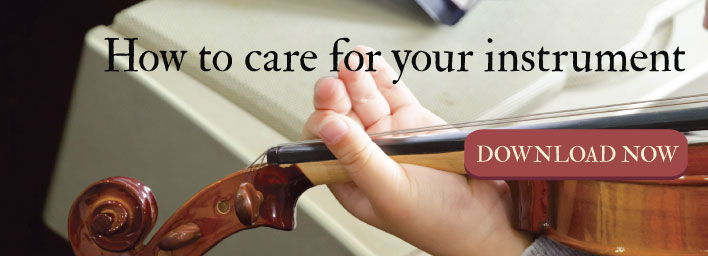Why Do My Violin Strings Keep Snapping?

Many beginner violin students (and even some seasoned players) struggle with frequently broken strings. Even if you set aside the repeated cost of buying individual strings (mostly E-strings), string problems can be quite dangerous, both to the tuner and to any other innocent bystanders who happen to be in the range of fire when the tensile strength reaches its breaking point.
However, if broken strings become commonplace every time you tune your violin there may be additional factors causing the situation. This list includes some of the most prevalent reasons and can help you identify ways to keep your strings from constant breakage.
It’s Your Violin’s Fault
Your violin doesn’t really want to be a source of pain and frustration for you—it only seems that way every time you try to tune it. Yet, it’s true that many problems with your strings can be traced back to a fixable problem on your violin.
Poorly Notched/Lubricated Bridge:
Your violin strings should sit flush within the respective notches on the bridge. If they are sitting on top of the grooves (because the slots or top nut is too narrow) then they won’t be able to slide properly while tuning. This generates a volatile stress point, which is typically followed by a snapping sound, whipping noises, and mumbled cursing.
Additionally, even if the slots are adequate, without the assistance of some type of lubricant, the friction can cause breakage. Use a regular graphite pencil to trace the grooves and top of your bridge before re-stringing your violin.
Tailpiece and Pegbox:
Again, if the slots in the tailpiece are too narrow, you can’t position the ball end properly because it won’t seat correctly. This can cause your violin strings to break by putting significant pressure, which is designed to be absorbed by the ball, directly on the string.
Moreover, you may discover that while tuning the string is getting wedged on the bottom of the pegbox, especially if you need to wind an excess amount onto the peg. This type of problem will eventually damage the peg and the box itself, so make sure that you are winding the strings properly when tuning and that you also only purchase the correct size strings for your size instrument.
Misshapen Top Nut:
Without the right curve on your top nut, it forces the string to bend at an unnatural angle. Too little curvature is just as troublesome as too steep an angle, because either way, the stress points created means that your strings will snap with regularity.
Fine Tuners:
Occasionally, fine tuners used on beginner and intermediate level instruments will feature sharp edges that may cause certain looped ended strings to break. Always make sure to gradually tune your strings to the correct pitch and try to avoid overtightening.
All of these problems are easily addressed by your local stringed instrument dealer or specialty shop.
It’s the Weather’s Fault
Since your violin was crafted with organic materials, changes in temperature and humidity levels cause it to expand and contract. And when the pegs that are holding your strings in place slip out or swell, you can be sure that the additional pressure or lack thereof will contribute to increased breakage. The worst case scenario is when you open your case and discover that all of your strings have come loose, dislodging the soundpost.
The most effective way to prevent the weather from affecting your strings is to keep your violin warm and at a constant humidity. Case inserts like mini humidifiers can help regulate the humidity, but if you need to transport it, treat your instrument as if it were your pet and avoid temperature extremes. Here are a few tips:
- Invest in a quality insulated hardcase for your violin
- Rather than risk swelling your violin with too much humidity, hang a few indoor plants in the room
- Never store your violin in a room with a wood burning stove or fireplace
It’s Your Own Fault
Although it can be hard to admit, sometimes the problems you’re having with your strings are the result of your own actions. One of the most crucial tasks to master early on involves knowing how to properly tune and re-string your violin. It’s very easy to gloss over that part of instruction so that you can move on to the fun stuff, like making music.
Your violin strings will break sooner, rather than later, if you constantly overtighten them or if they are wound incorrectly while re-stringing (of course, never remove all of your strings at once). Take your time learning the proper method for these tasks and you’ll soon discover that your violin strings not only last longer, but that they stay in tune longer too.


